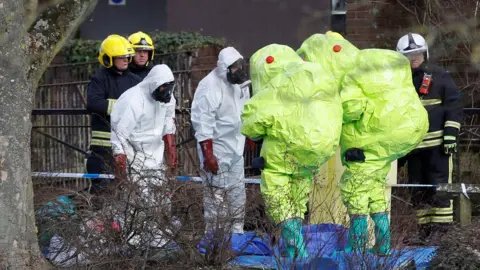Russian spy: What are nerve agents and what do they do?
 Reuters
ReutersSergei Skripal and his daughter Yulia were poisoned with a military-grade nerve agent of a type developed by Russia, known as Novichok, Theresa May has told MPs.
The former Russian spy and his daughter are critically ill after their attempted murder in Salisbury, Wiltshire, on 4 March. A police officer also remains in hospital after attending the scene.
The chemical was identified by experts at the defence and science laboratory at Porton Down, Mrs May said.
So what are nerve agents and what do they do?
What are nerve agents?
They are highly toxic chemicals that prevent the nervous system from working properly, and can be fatal.
Nerve agents take different forms - including powder and gas - but they tend to be a liquid, which can seep through the skin.
What are Novichok agents?
The name Novichok means 'newcomer' in Russian and applies to a group of advanced nerve agents developed by the Soviet Union in the 1970s and 1980s.
One of the chemicals - called A-230 - is reportedly five to eight times more toxic than VX nerve agent, which can kill a person within minutes.
A number of variants of this chemical have been manufactured, and one of them was reportedly approved for use by the Russian military as a chemical weapon.
Some of the agents are also reported to be 'binary weapons', meaning the nerve agent is typically stored as two less toxic chemicals. When they are mixed together, they react to produce the more toxic agent.
What are the different types?
Novichok agents are one of three classes of nerve agents - the other two are G-Agents and V-Agents.
G-agents include sarin while V-agents include VX, an oily amber-coloured liquid.
When have nerve agents been used in the past?
The half-brother of North Korean President Kim Jong-un was killed by a nerve agent in an attack in Malaysia last year.
Kim Jong-nam died in less than 20 minutes after two women smeared his face with VX nerve agent ingredients at Kuala Lumpur airport in 2017.
 TOSHIFUMI KITAMURA
TOSHIFUMI KITAMURAThe UN says the nerve agent sarin has been used by the Syrian government - in an attack on Ghouta, near Damascus, in 2013 and again in Khan Sheikhoun in the north-west of the country in April 2017, killing hundreds.
In an attack on Tokyo's subway system in 1995, which killed 13 people, liquid sarin was placed in plastic bags that were pierced by umbrellas with sharpened tips.
When Russian dissident Alexander Litvinenko was poisoned in London in 2006, a radioactive substance - not a nerve agent - called polonium 210 was used in a cup of tea.
What do they do to the body?
Nerve agents disrupt normal messaging from the nerves to the muscles. This causes muscles to become paralysed and can lead to the loss of many bodily functions.
Agents will act within seconds or minutes if inhaled and slightly more slowly if exposure is the result of skin contamination.

Symptoms include white eyes, as the pupils become constricted, convulsions, drooling and in the worse cases - coma, respiratory failure and death.
If you have ever sprayed insect repellent at a fly, you might have seen it drop to the ground and lie on its back, legs twitching. This is the result of nerve agents taking hold.
How are they delivered?
The nerve agent needs to be ingested, inhaled or to penetrate through the skin, so it usually requires the person delivering it to get very close to the people they are targeting.
Only tiny amounts are required for it to take effect. It is so toxic that it would usually be transported in something tightly sealed and those who apply it will need protective clothing.
Dr Andrea Sella, professor of inorganic chemistry at University College London, said because of the extreme toxicity of the nerve agents it would be "very dangerous" to the person who delivered the poisoning.
 Reuters
ReutersIs there a risk to the public?
Prof Dame Sally Davies, the chief medical officer for England, said the risk of harm in the Salisbury case was "low".
However, up to 500 people who went to the Mill pub and Zizzi restaurant in Salisbury city centre on Sunday afternoon and Monday have been told to wash their clothes and wipe possessions.
Dame Sally said there was some concern that prolonged exposure over weeks and months could cause health problems but it was "not a subject for panic" and the advice was a "belt and braces" measure.
"The risk to the general public remains low and I am confident none of these customers or staff will have suffered harm," she said.
Alastair Hay, professor emeritus of environmental toxicology at the University of Leeds, said if no one has had physical symptoms suggestive of nerve agent contact a week on, it was unlikely that they were at risk.
But washing provided the extra guarantee of safety, he added.
What is the treatment?
There are antidotes to help reverse the effect of nerve agents, which the emergency services hold.
But the sooner the treatment is delivered the better the chance of recovery.
Knowing the exact substance enables more targeted treatment.
Alastair Hay, emeritus professor of environmental toxicology, said the people affected may well have been treated with atropine, which is one of the chemicals used to treat individuals with this type of poisoning.
"The problem occurs if the treatment is not provided quickly," Prof Hay said.
"There is paralysis of the nerves and the muscles, and that inhibits breathing and leads to some damage in the brain. At this stage we don't know if that is a problem.
"Many people appear to recover without too many long-term problems but we won't know until we know the severity of their symptoms."

Where are they made?
Nerve agents are not materials that can be made at home.
Their level of toxicity is such that they are only allowed to be manufactured in specialised facilities, such as a university or industrial laboratory.
Discovered by accident in the 1930s by scientists trying to find a cost-effective pesticide, they proved to be highly toxic chemicals that eventually ended up in the hands of the German military.
Russia, the US and the UK also started to experiment on chemical agents after World War Two and it was British scientists who developed the VX nerve agent at the Porton Down research facility in the early 1950s.
How do you find where it came from?
The authorities would have been looking for the container used to deliver the material, as the chemical contents would be a "goldmine", Dr Sella said.
"With this information it might well be possible to trace the origin of the substance, just as has been done for the Khan Sheikhoun attack in Syria."
Chemical weapons expert Hamish de Bretton-Gordon said each country made chemical weapons "slightly differently" which might help scientists determine where this attack had come from.
"There is a footprint, there are markers," he said.
